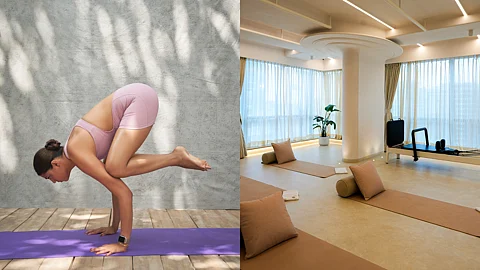
- HOMEGROWN WORLD
- #HGCREATORS
- #HGEXPLORE
- #HGVOICES
- #HGSHOP
- CAREERS
- ABOUT US
- CONTACT US

Day after day as attention-hijacking algorithms and constant overstimulation bombard us, more and more people are cultivating environments that ease the senses rather than compete for them. That’s the intention Anshuka Parwani, founder of Anshuka Yoga brought to her new yoga studio in Mumbai. “From the very beginning, I wanted the studio to feel like an exhale; a space where your nervous system starts to settle from the moment you walk in,” she explains.
This principle of interconnectedness that's embodied in the architecture of the studio is foundational to Anshuka’s practice. In fact, breath itself is the axis around which her teaching revolves. “It doesn’t matter how flexible you are; it doesn’t matter if you’re just sitting on a mat,” she says. “If you're disconnected from your breath, you're disconnected from what’s really keeping you present; keeping you alive.”
This reverence for breath comes from her own rediscovery of it. Long before she was known as the wellness coach to Bollywood celebrities or the founder of one of India’s most visible yoga platforms, Anshuka was a commercial pilot and a national gold-medalist swimmer who had, in her own words, always trusted her body “more than anything". That changed after a severe motorbike accident left her unable to walk for eight months. “My body felt extremely alien to me,” she recalls. “Everything came to a standstill. Even the smallest movements came with a lot of pain and limitation.”
Anshuka remembers a strange void or stillness settling in her — one that she didn’t know how to interpret. Although she wasn’t clinically diagnosed, she acknowledges that she was spiralling. It was her mother who recognised this internal shift and encouraged her to try yoga. After months of physiotherapy, she enrolled in a yoga school. It was the act of doing breath work or pranayama that quietly started to reshape her world.
This shift into intentional, mindful presence forms the core of what she wants others to experience too. “Most people treat their bodies like machines,” she says. “They don’t notice until something breaks or malfunctions.” But the body, she insists, is constantly communicating —through fatigue, tension, even the rhythm of your breath. Learning to listen before crisis strikes, she believes, is a way to live more wholly. “From the outside, wellness looks like a very luxury to-do list. But it’s not really about that. It’s about paying attention to those micro moments of wellness.”
This philosophy also shapes how she views yoga in public imagination. Many people come to her studio with rigid expectations: weight loss, increased flexibility, or simply the ability to perform impressive asanas. But Anshuka sees these as entry points, not endpoints. She’s not concerned with why someone starts, only that they begin. Once they’re there, her role is to help them shift perspective from how yoga looks to how it feels. She often returns to the idea of stillness as hyper-presence. When we’re truly still, she explains, we begin to notice everything. And that noticing leads to conscious choices.
For her, the ability to anchor herself in authenticity comes from having rebuilt from trauma, and realizing that true wellness doesn’t look perfect; it’s fluid, deeply personal, and sometimes messy, which reverberates across her classes as well as the digital platforms she inhabits. Whatever she posts, she tries to make it real, relatable, accessible, and actionable; filled with takeaways that can be practised alone.
Within a wellness industry increasingly driven by performance, aesthetics, and curation, Anshuka has had to consciously resist certain pressures. She believes real wellness must accommodate life’s variations. No two bodies, thoughts, or days are alike — and a one-size-fits-all routine will always fall short. Her advice to students is to enjoy the journey, rather than obsess over changing goals.
It’s a message that finds an expression in her new studio, with every visual element calibrated to reflect the way we breathe, move, and feel. “The spatial language really had to mirror the philosophy of spacious yet intentional, minimal but warm, rooted in stillness, and with room to expand", she shares. The design is grounded and elemental: earthy palettes, flowing spatial arrangements, soft light, and a column at the centre of the room, with an inverted wave frozen in time, that serves as a subtle metaphor for the impact of small, mindful decisions.
“One step into wellness creates a ripple effect of abundance,” says Anshuka, as she signs off.
Follow Anshuka here.
If you enjoyed reading this here's more from Homegrown:
Algae, Glass, & Bioleather: Inside Devanshi Jain’s Radical 'Neo-Luxury' Design Practice
Armaan Bansal Talks Recontextualising Indian Aesthetics, Design As Sensation, & More
Where Fabric Takes The Lead: Inside Studio Medium’s World of Textile First Design
